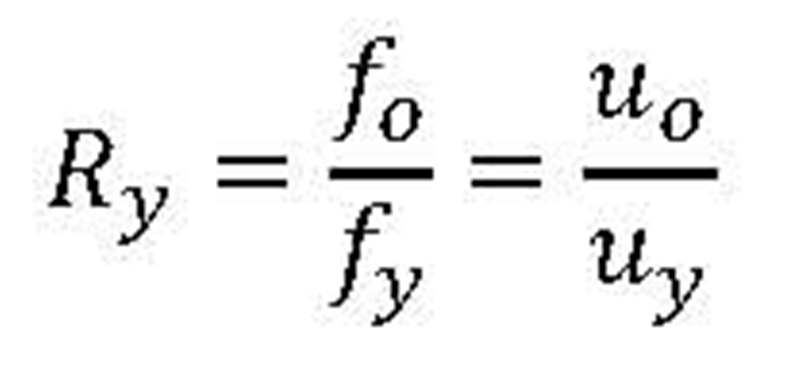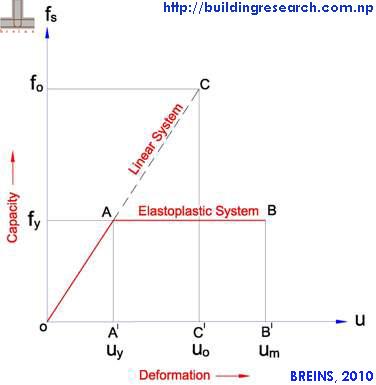
Today (NST)
Friday, Apr 25, 2025
Smart Search
Please post in your Technical Queries, Comments & Suggestions to Contact us......
Advertisement

For Advertisement
|
|
| Subscribe to BREINS Sci-Tech |
| Visit this group |

Seismic Resistant Design
Strength Reduction Factor & Ductility Demand
Earthquake induced forces in buildings range from mild to severe ones depending upon the magnitude of earthquake, distance from its point of origin (focus), building's own natural parameters and geotechnical factors.
It is quite difficult task to design structures behave elastically for a severe earthquake scenario - usually not feasible for most of the structures. Structures, therefore are usually designed for the earthquake load much lower than that can occur at the site. Even in earthquake resistant design provisions - structures intended for normal purposes are prescribed with lower design lateral strengths - typically lower than the lateral strength required to maintain the structures in an elastic range (elastic demand).
Reduction in load or strength is achieved by the application of a reduction factor - Strength Reduction Factor and structures invariably enter into inelastic zone in the process. Such inelastic behavior is maintained by its inherent ductility. Structures designed so are therefore bound to suffer permanent damages as inelastic displacements are irreversible.
Strength reductions from the Elastic Strength Demand, fo, are commonly
accounted for through the use of Reduction Factors, Ry; thereby imposing
some Ductility Demand, ![]() , on the structure - required to perform in an inelastic range. Ductility is a measure
of an ability of the structures/structural elements to deform (range AB in Fig-16) prior to failure, once the structure has attained
its yield strength, fy, in an elasto-plastic system.
Ductility,
, on the structure - required to perform in an inelastic range. Ductility is a measure
of an ability of the structures/structural elements to deform (range AB in Fig-16) prior to failure, once the structure has attained
its yield strength, fy, in an elasto-plastic system.
Ductility, ![]() , a dimensionless
quantity is expressed as a ratio of ultimate deformation, um, to yield deformation, uy, as;
, a dimensionless
quantity is expressed as a ratio of ultimate deformation, um, to yield deformation, uy, as;
 (4)
(4)
The reduction in strength demand is due to nonlinear hysteric behavior. Thus the component of the Strength Reduction Factor due to nonlinear hysteric behavior is defined as the ratio of the elastic strength demand, fo, to the inelastic strength demand , fy, as;
 (5)
(5)

Fig-16 (A Linear system and its corresponding Elasto-Plastic System)
It should be remembered that for a given ground motion Ductility
Demand,![]() , of a
structure is a function of its natural frequency, damping ratio and
corresponding Reduction factor. For the structure with very long natural
time period, that lies in a displacement sensitive region of the spectrum,
Ductility demand is equal to the Reduction factor. Whereas, Ductility
demand is quite high for very short period systems, that lies in a acceleration
sensitive region of the spectra. Also, for the system in velocity sensitive
region of the spectrum, Ductility demand may be larger or smaller than
the Reduction factor.
, of a
structure is a function of its natural frequency, damping ratio and
corresponding Reduction factor. For the structure with very long natural
time period, that lies in a displacement sensitive region of the spectrum,
Ductility demand is equal to the Reduction factor. Whereas, Ductility
demand is quite high for very short period systems, that lies in a acceleration
sensitive region of the spectra. Also, for the system in velocity sensitive
region of the spectrum, Ductility demand may be larger or smaller than
the Reduction factor.
Moment resisting frames are well suited to accomodate high levels of inelastic deformation imposed by these Reduction factors. It is usual to assign the end zones of the flexural beams to accept the post-elastic rotation expected.
In reinforced concrete (RC) structures, it is required that "Rotational ductility" at the critical sections shall be maintained as per the reduction factor. This helps to rotate or deform the sections even at the higher loads than the design loads; thereby preventing the collapse of the entire structure.
Higher the load reduction factor, higher should be the rotation capacity. Though the reinforced concrete (RC) section has limited amount of ductility; satisfactory rotation capacity at any section of the structure could be achieved by keeping that section highly under-reinforced.
This step is the most important factor in the Earthquake Resistant Design (ERD).

Fig-17 (Proper anchorage and ductile detailing at the exterior Beam-Column joint)
Also, sound structural detailing that complies mathematical model prepared during analysis phase with the real physical model to be built at the site is also an important step. It simply enhances the structural performance as per the predicted manner. Proper anchorage of main rebars, provision of closely spaced stirrups at major structural joints (Fig-17) and at other locations and maintaining proper rebar spacings and concrete cover help to develop full design strength, ductility and durability.